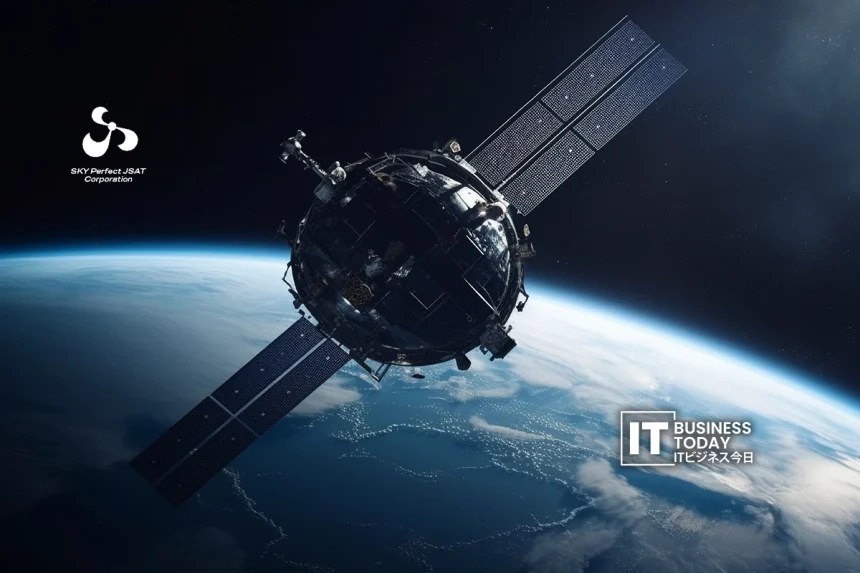SKY Perfect JSAT Corporation, a Japanese satellite operator, is launching new satellites. This new generation will greatly enhance onboard Wi-Fi services. This move shows the rising demand for strong, high-capacity connections. The company plans to launch satellites made for mobile use. These will provide Wi-Fi on planes and ships, plus fast internet on board. Details about the launch are still limited.
The announcement & core developments
SKY Perfect JSAT is boosting its investment in advanced satellite infrastructure for mobility. By 2027, the firm will launch JSAT-31 HTS. This strong platform, made by Thales Alenia Space, works in both Ka- and Ku-bands.
Next-generation satellites will have big capacity upgrades. They will have flexible software-defined payloads. This will help them cover a larger area, including Japan, Southeast Asia, and the Pacific.
Also Read: IHI and Space Data Partner to Expand Satellite Services
While the original announcement was focused on extension of broadband Wi-Fi service onboard vessels and aircraft, it talked about disaster-resilient communications and flexible mobility-oriented spot-beam coverage as well. Although direct figures regarding “onboard Wi-Fi improvements” were not published in full, the implication is clear: SKY Perfect JSAT gets ready for a surge in satellite-based mobility connectivity.
Why it matters for Japan’s technology and telecom ecosystem
At a foundational level, this move signals Japan’s broader pivot toward non-terrestrial networks and mobility-enabled connectivity. For Japan’s tech industry, this means several things:
Satellite mobility as a growth frontier: Traditional satellite services in Japan have centered on fixed broadcasting, fixed VSAT, and backhaul. The shift toward aircraft, maritime, rail, and other mobility segments opens up new growth vectors. In the case of SKY Perfect JSAT, the decision to build satellites with “mobility beams” and software-defined re-configurability shows that the firm is positioning for future demand. By selecting JSAT-31 and JSAT-32 platforms with mobility-specific coverage, they’re aligning with the rising demand for connectivity in transit sectors.
Oonboard connectivity benchmark: Airlines and transport operators globally consider high-capacity satellite Wi-Fi a competitive differentiator. In Japan, this announcement gives domestic carriers and transport firms a local supplier (or partner) with tailored coverage over the region. This may accelerate adoption of premium onboard connectivity packages, IoT/monitoring onboard vehicles, and constant-link operations (e.g., via trains, ships). For tech-equipment vendors (antennas, on-board routers, ground stations) this expands the opportunity base.
Boost to ground-segment, antenna and mobility ecosystem: Enhanced onboard Wi-Fi isn’t just about space assets: it requires ground stations, in-flight or in-vessel installations, network orchestration, hybrid satellite-terrestrial integration, and service platforms. Japanese antenna specialists, tracking system experts, mobile network integrators, and cloud back-end developers will benefit from this investment. As connectivity demands rise, the whole ecosystem will benefit. This includes uplink, telemetry, and user-experience platforms.
Competitive pressure and global relevance: Global players, like U.S. carriers, are teaming up with low-earth orbit systems to provide high-speed onboard Wi-Fi. Japan must keep up.
This initiative by SKY Perfect JSAT will further help Japan avoid the risk of lagging behind in terms of mobility broadband infrastructure.
Effects on businesses operating in this industry
The ripple-effects for companies operating in satellite communications, aviation connectivity, mobility services, and digital platforms-both domestic and international-are huge:
Japanese aviation and transport operators could thus expect increasing demands from passengers for highbandwidth, seamless Wi-Fi. Airlines, cruise liners, and rail operators would need to assess whether to take up the services offered by these satellitemobility operators, invest in onboard infrastructure, and reconsider service classes.
Satellite ground-segment vendors- that is, earth stations, gateway networks, and network-management software-may see increased demand as carriers and transport providers integrate these new satellite services. Japanese gear makers and service integrators can scale.
Japan’s satellite manufacturing and launch supply chain may start to pick up. The large-scale procurement of JSAT-31/32 by SKY Perfect JSAT with mobility-tailored coverage will drive order flows into satellite-bus manufacturers, payload contractors and launch-service providers.
Improved onboard connectivity will enable digital service and application firms to develop new services: inflight entertainment, remote operations, IoT on ships/trains, tele-presence, real-time monitoring. In fact, the improved bandwidth and reliability open up new business models both for B2B and B2C.
Japanese regulators and groups, such as JAXA and the National Institute of Information and Communications Technology, face important challenges ahead. They need to address spectrum allocation. They must also create rules for mobility satellites and certify the equipment in vehicles. To avoid costly delays, businesses must address compliance and licensing issues right away.
Challenges and strategic risks to watch
While promising, this initiative also brings challenges:
Latency, Cost, and Competition: Mobility-satellite services are mostly confronted with higher latency and cost relative to ground networks. Competing options like terrestrial 5G/6G and emerging LEO constellations might challenge the business model. Japanese firms will have to optimize cost per bit and ensure service reliability.
Onboard implementation complexity: Airlines and ships would have to retrofit the needed antenna systems, integrate satellite links with onboard networks, and manage seamless handovers across regions. Infrastructure investment and certification cycles may also delay rollout.
Spectrum and orbital slot constraints: Geo-stationary, or large GEO-HTS satellites, operate within tight regulatory and orbital slot regimes. Ensuring capacity maintenance, redundancy, and service resilience in disasters will continue to be of key importance – and added cost – for SKY Perfect JSAT and its partners.
Global supply-chain and launch cost risk: Increasing launch costs, geopolitical unrest and manufacturing supply-chain bottlenecks (e.g., payload electronics) can impact schedule, cost and competitiveness.
Conclusion
SKY Perfect JSAT has launched next-generation satellites. These high-throughput satellites are designed for mobility and onboard broadband. This is a big step forward for Japan’s space-connectivity industry. This move positions Japan to meet the growing demand for in-transit connectivity. This covers aviation, maritime, rail, and other mobility areas. It creates new chances for hardware vendors, service integrators, content companies, and transport operators. Japan is focusing on mobility-satellite networks. This shows it’s serious about leading in global connectivity. They face challenges like cost, implementation, and competition, but remain determined.This is a signal for technology firms: the space-based connectivity ecosystem is moving from fixed remote links toward mobility-first architectures. Product-roadmaps, partnerships, and service offers will need to be adjusted in line with it. Japan, with firms like SKY Perfect JSAT leading the charge, might actually be at the forefront of this shift.







